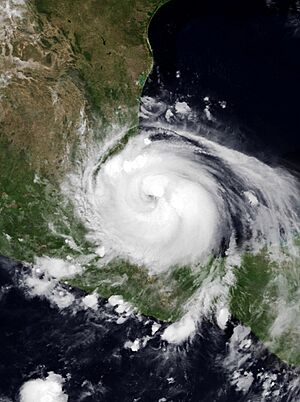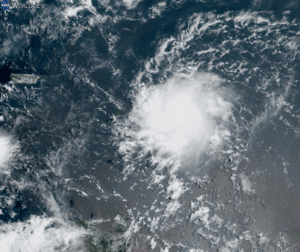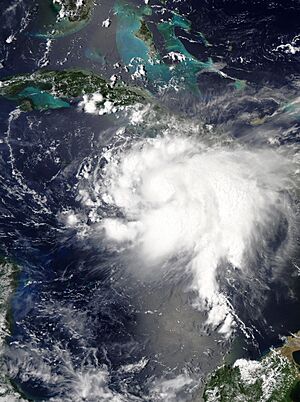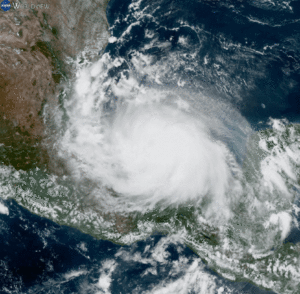Hurricane Grace facts for kids

Grace at peak intensity shortly after landfall in Veracruz on August 21
|
|
| Meteorological history | |
|---|---|
| Formed | August 13, 2021 |
| Dissipated | August 21, 2021 |
| Category 3 tropical cyclone | |
| 1-minute sustained (SSHWS/NWS) | |
| Highest winds | 120 mph (195 km/h) |
| Lowest pressure | 967 mbar (hPa); 28.56 inHg |
| Overall effects | |
| Fatalities | 16 |
| Damage | $513 million (2021 USD) |
| Areas affected | Lesser Antilles, Greater Antilles, Yucatan Peninsula, Central Mexico |
|
Part of the 2021 Atlantic hurricane season |
|
Hurricane Grace was a very strong tropical cyclone that hit the Mexican state of Veracruz. It was the most powerful storm to make landfall there. Grace first affected islands like the Leeward Islands and Greater Antilles as a tropical storm. Later, it caused much more damage in the Yucatán Peninsula and Veracruz as a full hurricane.
Grace was the seventh storm to be given a name, the second hurricane, and the first major hurricane of the 2021 Atlantic hurricane season. It started from a tropical wave in the Atlantic Ocean. It became a tropical depression on August 14 and then Tropical Storm Grace. After weakening, it grew stronger again, becoming a hurricane on August 18. It hit the Yucatán Peninsula as a Category 1 hurricane.
After crossing the Yucatán, Grace moved into the Bay of Campeche. There, it quickly became much stronger, turning into a Category 3 hurricane in about 24 hours. The storm then made its final landfall in Veracruz at its strongest point. It quickly weakened over Mexico but its leftover parts later formed into Tropical Storm Marty in the Eastern Pacific.
In Haiti, Grace made things worse after a big earthquake had happened just three days before. In Jamaica, streets were flooded and power went out. In Mexico, the storm caused landslides and destroyed buildings. Sadly, Grace caused 16 deaths: 4 in Haiti and 12 in Mexico. The storm also caused about $513 million (in 2021 USD) in damages.
Contents
How Hurricane Grace Formed and Moved
Hurricane Grace started from a tropical wave that moved off the coast of Africa on August 9. On August 10, weather experts began watching a disturbance near the Cabo Verde Islands. By August 13, this system was named Potential Tropical Cyclone Seven while it was east of the Leeward Islands.
The next day, on August 14, it became Tropical Depression Seven. Later that same day, it grew stronger and was named Grace when it had tropical storm-force winds. However, strong winds high up in the atmosphere made Grace weaken back into a tropical depression on August 15.
Grace then hit the Barahona Peninsula in the Dominican Republic on August 16. It continued moving west-northwest, passing near the south coast of Haiti on August 17. After a special flight found stronger winds, Grace was upgraded to a tropical storm again southwest of Haiti. About 11 hours later, Grace made landfall in Jamaica near Annotto Bay, Saint Mary Parish, with winds of 50 mph (80 km/h).
After leaving Jamaica, Grace moved into the Caribbean and became stronger again. It passed south of the Cayman Islands. By August 18, a special "Hurricane Hunters" flight found that Grace had become a Category 1 hurricane. The storm reached its first peak strength early on August 19 with winds of 80 mph (130 km/h). It then made its first landfall near Tulum, Quintana Roo in Mexico. After hitting land, it weakened back to a strong tropical storm.
Grace spent almost 12 hours over land before moving into the Bay of Campeche. The storm then started to get stronger again, becoming a hurricane by August 20. It quickly grew much more powerful, becoming a Category 2 hurricane by early August 21. Just three hours later, it became a Category 3 hurricane.
Around 05:30 UTC on August 21, Grace made another landfall in Mexico near Tecolutla, Veracruz. It hit at its strongest point, with winds of 120 mph (190 km/h). This was the strongest hurricane landfall ever recorded in Veracruz. After hitting land, Grace quickly weakened over the mountains of Mexico. It became a tropical storm three hours later and then just a tropical disturbance. The leftover parts of Grace later reformed into Tropical Storm Marty in the Eastern Pacific on August 23. Marty was a short-lived storm.
Getting Ready for Grace
People in many areas prepared for Hurricane Grace as it moved across the Atlantic.
Leeward Islands Preparations
When Grace was first named Potential Tropical Cyclone Seven on August 13, tropical storm watches were put in place for islands like Antigua and Barbuda, Saint Kitts and Nevis, and Montserrat. This meant that tropical storm conditions were possible soon. The French government also issued watches for Saint Martin and Saint Barthelemy. More watches and warnings were later issued for the U.S Virgin Islands and Puerto Rico.
Later that day, these watches became tropical storm warnings for many of these islands. A warning means tropical storm conditions are expected.
Hispaniola Preparations
In the Dominican Republic, a tropical storm watch was issued for the south coast as Grace got closer. As the storm approached, a tropical storm warning was put in place for part of the coast. All warnings were lifted after Grace left the Dominican Republic on August 16.
On August 14, a tropical storm watch was issued for the entire coast of Haiti. Experts thought 4 to 7 inches of rain would fall. Grace's impact on Haiti was especially difficult because a strong earthquake had hit the country just days before.
Jamaica Preparations
When Grace was still a tropical depression, a tropical storm watch was put in place for all of Jamaica. This watch stayed until Grace was about to hit the island. On August 17, a tropical storm warning was issued, meaning Grace was expected to make landfall. After Grace left the island, the warning was removed on August 18. Two shelters were opened across the country to help people stay safe.
Cayman Islands Preparations
The Cayman Islands were put under a tropical storm warning on August 16. This was upgraded to a hurricane watch on August 17 as Grace got closer to Grand Cayman. The emergency center was activated, and emergency services were ready. The Cayman Islands Regiment and Cayman Islands Coast Guard helped with disaster response. The Cayman Islands Cadet Corps helped answer phones. Schools were closed, and shelters opened on all three islands. Roads were checked for drainage, and Cayman Airways canceled flights.
Cuba Preparations
In Cuba, most of the preparations were for the southern and eastern coasts. A tropical storm watch was issued for the southern provinces. The hurricane passed on August 17, affecting cities like Santiago de Cuba and Camaguey.
Mexico Preparations
On August 17, Mexico's government issued a hurricane watch for the Yucatan Peninsula. This meant a hurricane landfall was possible. Later that day, a hurricane warning was put in place for the east coast of the Yucatan Peninsula. A tropical storm watch was issued for the west coast, which later became a warning.
A hurricane watch was also put in place for the Gulf coast of Mexico, from Puerto Veracruz to Cabo Rojo. Weather experts predicted 6 to 12 inches of rain, with some areas getting up to 18 inches. After Grace hit the Yucatan, the hurricane warning there was changed to a tropical storm warning. A hurricane warning was then issued for Puerto Veracruz to Cabo Rojo. All warnings were lifted by August 21 when Grace weakened.
Impact of Hurricane Grace
Hurricane Grace caused damage and disruption across the Caribbean and Mexico.
Caribbean Impacts
Grace's path through the Caribbean caused about $30 million in damages.
Dominican Republic
As a tropical depression, Grace brought heavy rains to the Dominican Republic. This caused flooding and damaged about 500 homes. More than 2,400 people had to leave their homes.
Haiti
Grace brought heavy rainfall to Haiti, with some areas getting around 10 in (250 mm) of rain. This caused flooding in areas that had just been hit by a big earthquake. Strong winds damaged homes that were already weakened by the earthquake. Grace's arrival made it harder for rescue and relief teams to help people. An overcrowded hospital in Les Cayes had to move patients. Shelters were damaged, meaning earthquake victims lost the little food they had. Rescue operations were temporarily stopped on August 17 because of the storm. Sadly, Grace caused four deaths in Haiti.
Jamaica
On August 18, Grace made landfall in Jamaica. The storm brought strong winds up to 53 mph (85 km/h) and very heavy rainfall, with 248 mm (9.8 in) recorded in Kingston. Power outages happened in all parts of the island, with 100,000 customers losing electricity. Power lines and poles were damaged. In Saint Andrew Parish, wet ground caused a power pole to fall. Many areas experienced flooding. In Clarendon, drivers had to take detours because roads were flooded. The Rio Cobre river flooded, and some drivers had to be rescued by the fire department. Strong winds also damaged banana and plantain farms. The roof of a fire station in Annotto Bay was blown away.
Cayman Islands
Grace caused minor impacts on Cayman Brac and Little Cayman. However, it had a stronger impact on Grand Cayman, which experienced hurricane-force winds. Large trees fell, and many roofs were damaged. Some buildings that were not built very well had major damage. Several utility poles fell, and damage to the electrical system caused Grand Cayman to lose power. Heavy rains led to flooding across the island. Storm surge caused some beach erosion and blocked coastal roads. Several boats broke free from their moorings and sank. A Cayman Airways plane also moved from its parking spot and crashed into an airport fence. The Cayman Islands Regiment and Cayman Islands Coast Guard helped rescue people from damaged buildings and flooded areas.
Mexico Impacts
The total damage in the Yucatán Peninsula and mainland Mexico was about US$300 million.
Yucatán Peninsula
Hurricane Grace caused fairly minor damage across the Yucatán Peninsula. The biggest impact was power outages, with over 180,000 people losing electricity. In Tulum, where the storm first hit, damage was mostly to power lines, trees, and some flooding. Things returned to normal the morning after Grace passed. Emergency services received 78 calls during the storm, and 337 people were rescued or evacuated. No injuries were reported. Twenty schools in Quintana Roo had minor damage, costing about 1.7 million pesos (US$83,500).
Elsewhere in Mexico
Grace hit Veracruz as a powerful Category 3 hurricane, causing significant damage in 58 of the state's 212 towns. Severe flooding was reported in Xalapa and other areas in Veracruz after the storm's second Mexican landfall. Grace blew off windows, uprooted trees, and knocked down power and telegraph poles, leaving debris everywhere in Tecolutla.
The governor of Veracruz, Cuitláhuac García Jiménez, stated that eight people died from Hurricane Grace in the state. Six of these deaths were from the same family in Xalapa when a landslide buried their home. Another person died from flying debris in Poza Rica, and an eighth person died from a landslide in the state capital. About 3,000 schools in the state were damaged, delaying the planned return to in-person classes.
Five people died in the state of Puebla: two from landslides, one from flying debris, one from a fallen tree, and one from a heart attack. An estimated 20,000 homes were damaged or destroyed across Puebla, and power outages affected over 315,000 people. Heavy rains from the leftover parts of Grace caused a rockslide near Mazatlán, Sinaloa, which sadly killed one person. There was also some street flooding in the city.
See also
 In Spanish: Huracán Grace para niños
In Spanish: Huracán Grace para niños
- Weather of 2021
- Tropical cyclones in 2021
- List of Category 3 Atlantic hurricanes
- Hurricane Hilda (1955) – A hurricane that also impacted the Yucatán Peninsula and Veracruz as a Category 3 hurricane
- Hurricane Diana (1990) – A Category 2 hurricane that made landfall in similar parts of Mexico
- Hurricane Emily (2005) – A Category 5 hurricane that directly impacted the Yucatán Peninsula as a Category 4 hurricane
- Hurricane Dean (2007) – An extremely powerful hurricane that took a very similar track to Grace and made landfall in the Yucatán Peninsula as a Category 5 hurricane
- Hurricane Franklin (2017) – A category 1 hurricane that struck Veracruz and the Yucatán Peninsula.
- Hurricane Katia (2017) – last storm to impact Veracruz prior to Grace




